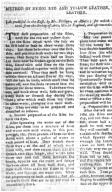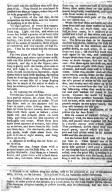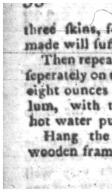[ Method of Dying Red and Yellow Leather, called Turkey Leather ] Mr. Philippo
Date: 1790/11/03
Source:
Nova Scotia Magazine
Institution: Nova Scotia Archives
| Source Origin: Nova Scotia Newspapers on Microfilm
| Reference: Microfilm Reels 8062, 8063
Instructions for dyeing leather. nn.336_38. Microfilm Reel 8063.
METHOD OF DYING RED AND YELLOW LEATHER, CALLED TURKEY
LEATHER.
[As practiced in the East, by Mr. Philippo, an Asiatic; for which be received a Reward of
100£ from the Society of Arts, &c. in England, and afterwards their Gold Medal.]
THE first preparation of the skins,
both for the red and yellow dyes.
Let the skins dryed with the hair on
be first laid to soak in clean water three
days. Let them be broken over the flesh,
side, and put into fresh water for two days
more, then hung to drain half an hour.
Let them now be broken again on the flesh
side, limed with cold lime on the same
side, and doubled together with the grain
side outward. Thus they must be hung
within doors on a frame five or six days,
till the hair be loose, which must then be
taken off, and the skins returned into the
lime pit for three weeks. Take them then
out, and work them well, flesh and grain,
every sixth or seventh day during that
time; after which wash them ten times
in clean water, changing it at each wash-
ing. They are next to be prepared and
drenched as follows.
2. Second preparation of the skins for
both the dyes.
After squeezing the water out of the
skins, put them into a mixture of bran
and water new milk warm, in this pro-
portion, viz. three pounds of bran for five
skins, with about a gallon of water to
each pound of bran. Here drench them
three days; at the end of which work
them well, and then return them into the
drench two days longer, after which take
them out and rub them between the
hands, squeeze out the water and scrape
the bran clean off from both sides, and
then wash them again ten times in clean
water, and squeeze the water out. Thus
far preparatory to both colours; but af-
terwards those that are to be red must be
created as follows.
3. Preparation in honey and bran.
Mix one pound of honey with three
pints luke warm water, and stir them well
till the honey be dissolved. Then add
two double handfuls of bran; and taking
four skins (for which this quantity will
suffice) work them well in it separately.
Then fold each separately into a round
form, the flesh side outward, and lay them
in an earthen pan, side by side, in summer,
and in winter on top of each other. Place
the pan sloping that the fluid may run
spontaneously from them. An acid fer-
mentation will then arise in the liquor,
and the skins will swell considerably. Thus
let them continue seven or eight days, but
the draining moisture must be poured off
once or twice a day; after which the next
preparation will be necessary.
4. Preparations in salt.
After the last mentioned fermentation,
take the skins out on the ninth or tenth
day, and rub them well with dry common
salt, about half a pound to each, which
must be well worked into them. Then
they will contract again, and part with a
considerable further quantity of liquid,
which squeeze out by drawing each
through the hands. Next scrape them
clean on both sides; after which strew
dry salt over the grain sides and rub them
well. Then double them length wise,
from tail to tail, the flesh side outward,
and strew more salt thinly on the flesh side,
rubbing it in. For which two last ope-
rations a pound and a half may suffice to
each skin. Then put them, folded on each
other, between two clean boards, placed
sloping breadthwise, and a heavy weight
laid on the upper board, in order gradual-
[page break]
ly to press out the moisture they will thus
part with. They should be continued so
pressed two days or longer, when they will
be duly prepared for dying.
5. Preparation of the red dye, in the
proportion for four skins, and the manner
of applying it to the skins.
To eight gallons of water in a copper,
put seven ounces of Shenan* tied up in a
linen bag. Light the fire, and when the
water has boiled a quarter of an hour, take
out the bag, and put into the water still
boiling, two drams of allum, three quart-
ers of an ounce of turmeric, three ounces
of cochineal, and two ounces of loaf su-
gar. Then let the whole boil six minutes
longer.
Put two pints of this liquor into a flat
earthen pan; and when cool as new milk,
take one skin folded lengthwise, grain side
outward, and dip it in the liquor, rub-
bing it gently with the hands, then take it
out and hang it to dry. Proceed thus
with the rest of the skins seperately, eight
times before each fresh dipping, squeezing
them by drawing through the hand. Then
lay them on one side of a large sloping
pan, for as much of the water to drain as
may be without pressure in two hours, or
till cold.
6. Of tanning the red skins.
Powder four pounds of fine white galls,
in a marble mortar, sift them fine, and
mix-them in three quarts of water. Work
the skins well in this mixture half an
hour or more; then folding them four-
fold, let them lye in it twenty four hours;
then work them again as before; when
taken out and scraped clean on both
sides, put them into the like quantity of
fresh galls and water. Work them here
again three quarters of an hour, fold them
up as before, and leave them in this fresh
tan three days. On the fourth, take them
out again, wash them clean from the
galls in seven or eight waters, and hang
them up to dry.
7. Manner of dressing the red skins af-
ter tanning.
When near dry, scrape them with a
proper scraper, on the flesh side, to a re-
quisite thickness. Lay them on a smooth
board, and glaze them with a sleek stone.
After this, rub them with olive oil, and
linen rag, an ounce and half of oil to four
skins; then grain them on the graining
board, lengthwise, breadthwise, and cross-
wise from corner to corner.
8. Preparation with galls of the skins
for the yellow dye.
When the four skins are taken out of the
bran drenched and clean washed as before
directed, Art. 2d. work them very well
half and hour more, in a mixture of one
pound and a half of fine white well pow-
dered galls, with two quarts of clean wa-
ter. The skins are then to be separately
doubled lengthwise, rolled up the flesh side
outward, laid in the mixture, and close
pressed down, on each other, so to con-
tinue two days; the third day work them
well again in the tan, and afterwards
scrape them clean from the galls with an
ivory of brass scraper, but not an iron
one. Put them again into fresh tan, made
of two pounds of galls with three quarts
of water, and work them well in it fifteen
times. After this, double and roll them
up as before, and lay them in the second
tan two days: on the third, work a quar-
ter of a pound of a white sea salt into each
skin, and double and roll them up as be-
fore, to be returned into the tan till the
day following, when they must be taken
out and well washed six times in luke
warm. Squeeze the water by keeping
the skins under pressure between boards
half an hour, with two or three hundred
pounds weight on the upper board, then
they will be ready for the dye.
9. Preparation and application of the
yellow dye for four skins.
Mix six ounces of Cassiari Gehira, or
Dgehira,t with the same quantity of al-
lum, and pound them together till fine,
in a marble mortar with a brass pestle.
Thus powdered, divide them into three
equal parts, one of which put into a
pint and half of hot water in an earthen
vessel and stir the mixture.
Let the boiled fluid cool till the hand
can bear it. Then spread one of the
skins on a flat table in a warm room, the
grain side upward; and pour a quarter
of the tinging liquor, prepared as here di-
rected, over the grain side, spreading it e-
qually over the skin with the hands, & rub-
bing it well in. Do the like with the other
[page break]
three skins, for which the mixture first
made will suffice.
Then repeat the operation twice more,
seperately on each skin, with the remaining
eight ounces of powder of berries and al-
lum, with the aforesaid proportions of
hot water put to them as before.
Hang the skins when dyed, upon a
wooden frame, the grain side outwards,
without folding, and let them drain three
quarters of an hour, then wash them six
times, or more, in a running stream; which
done, press them about an hour to squeeze
out the moisture, and hang them up to
dry in a warm room.
Lastly, dress and grain them, as directed
for the red ones; except that these must
not be oiled.
Download: Transcription | Images


